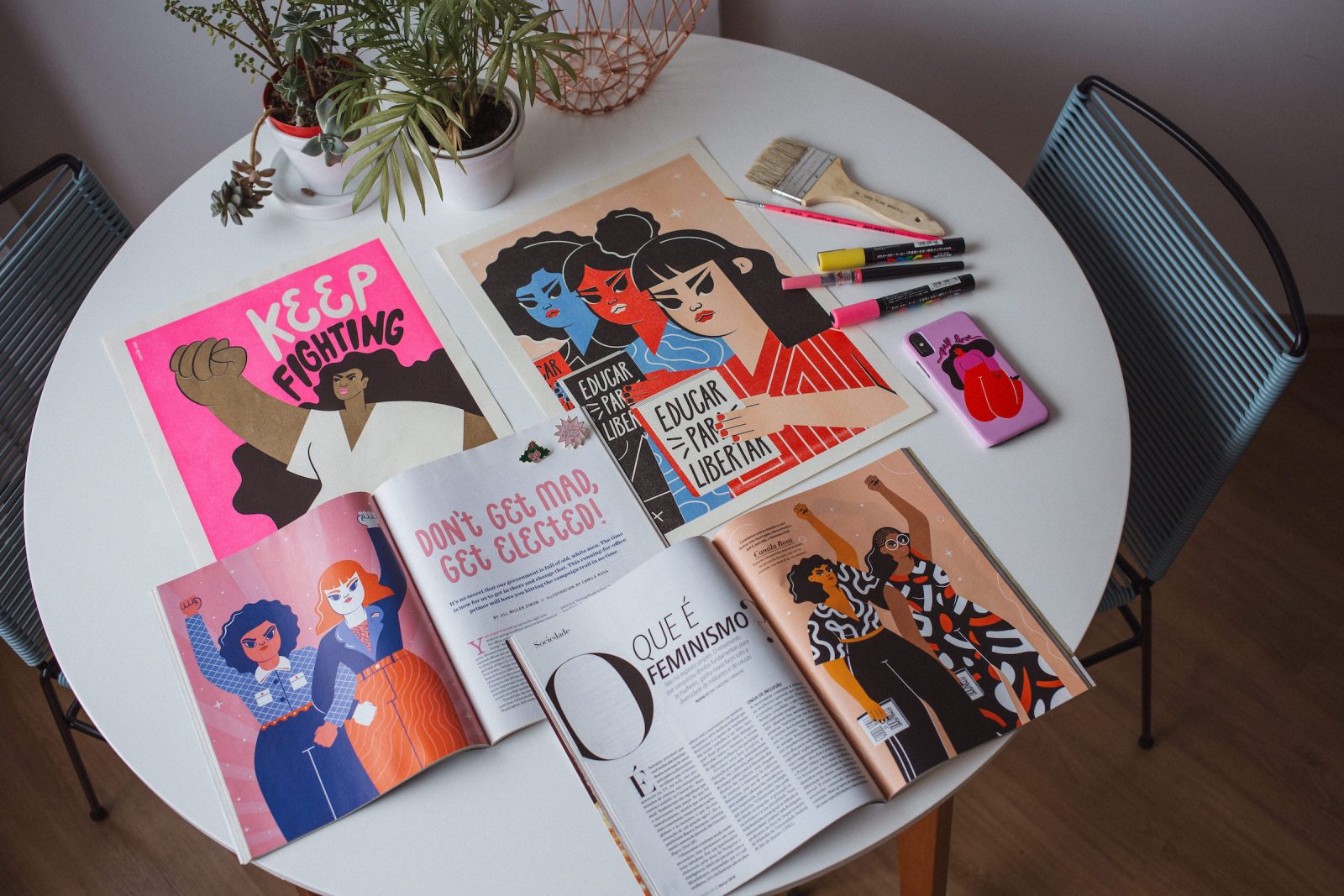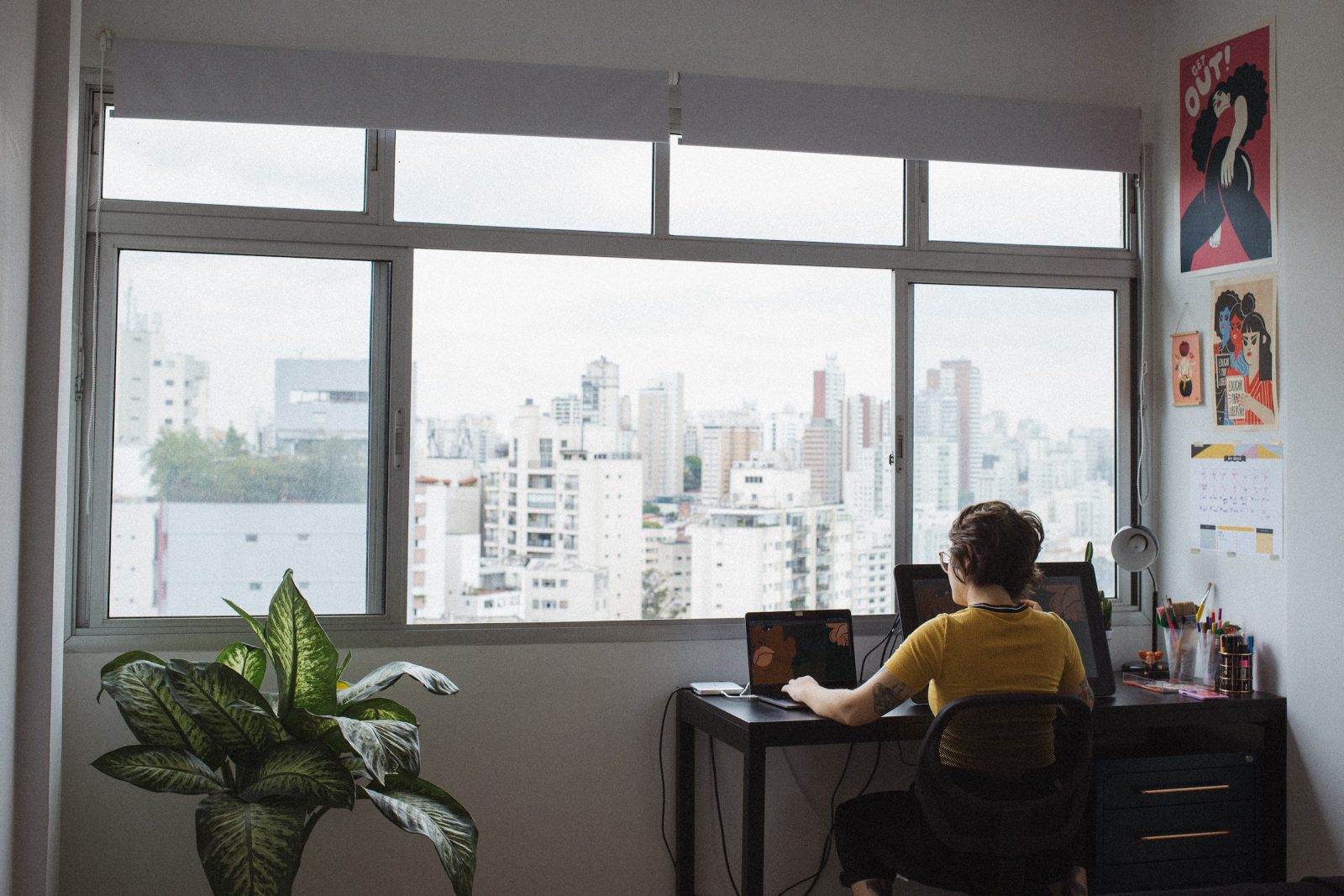Everyone is creative. Whether you’re a painter, a woodworker or an accountant—we all have our own ways of engaging with creativity every day. That’s why we’re partnering with Bombay Sapphire, to celebrate their commitment to help everyone find their canvas. Here, we’re taking a closer look at Brazilian illustrator Camila Rosa.
Looking at the work of Camila Rosa, you’re confronted with a bold subtlety—neon colors and oversized figured meet curved lines and placid expressions. This all feels reminiscent of Camila herself, who is so joyful and congenial that you’d never guess she was an active member of the hardcore punk scene.
Here, we sit down with the oft political artist to chat about her inspirations, the tumult of her home country Brazil and how she’s working towards her goal of becoming a full-time artist.
Hey Camila! Before we dive in, would you mind introducing yourself with a bit about where you’re from, where you live now and your artistic style?
Sure! I’m Camila Rosa. I’m from Joinville, a small city in the south of Brazil. I consider my artistic style like something bold, colorful and with a strong message. It’s the way I like to present myself to the world.
When did you first get into political art? What drew you to that style?
I started to add political views in my work around 2015. In a very subtle way, I was adding a bit of my thoughts on the world into my drawings. In 2016, this insertion became stronger due to the conservative rise we began to face in the world. But political urgency has been present in my personal life since I was 13 years old when I was introduced to the hardcore-punk music scene. The critical and political thought took me over and educated me about several topics such as feminism, veganism, LGBTQ+ rights, etc. Later, when I was 16 years old, I used to put up posters for punk gigs and political protests in my city. So in every way, it has always been part of my essence; it just took me a while to realize I could incorporate that into my work and into the language and style I was developing. But only after that process did I finally find myself as an artist.
You’ve mentioned before that Emory Douglas and the underground/punk scene of the 80s are influences in your work—what about them interests you? Can you point to specific aspects of their work that you’ve adapted into your own?
Sure. Emory Douglas was a big influence of mine regarding style and color use. Using message in a simple and straight-forward fashion, he changed the way social movements used to communicate in the late 60s. The Black Panther Party newspapers designed by him are extremely rich material for a time when computers weren’t even around. That really influenced my perception of having strong and direct messages in my illustrations.
Regarding the underground/punk scene, no doubt my major influence was D.I.Y culture. It was all about understanding I could create my own materials and design them in my own way, regardless of anything else. D.I.Y is about creative freedom. Beyond that, the fanzines and gig posters always taught me that message is the hero, it’s not about having the best visuals, or about the band with the best technical music composition. This is something present both in Emory Douglas and the underground/punk scene.
I imagine navigating the line between creating art with a purpose or to serve a message, and creating art to make a living is tricky. Can you speak to that divide?
Sure, it is! I’ve found a way to work out these two parts of my life as an artist and illustrator. I believe that is the reason I call myself both. My artistic work contains this political force and brings me the emotional support to keep living and believing in my work as a transformative force, for me and for those who like what I do. On the other hand, my work as an illustrator is more commercial and doesn’t always have a connection with my political views (even though I’ve been lucky to be commissioned mainly because of my political artwork), but at the end of the day, it pays the bills. The artist, as any other human being inserted in capitalist society, has to pay bills in order to survive. Especially in a “third world” country like Brazil, which is not the best place in terms of opportunity equality, so to speak. So, nowadays, I deal with it easily and keep things separate. This impacts directly the way I charge for my work, for example—commercial projects will always cost more than political proposed projects.

Brazil is going through quite a period of political turmoil these days and I’m curious what your thoughts on the country at large are? What are the biggest struggles it faces and what is the future you’d love to see in Brazil?
There are so many problematic things going on in Brazil that is hard to know where to begin. Firstly, as all of you have been reading recently, we have one of the most conservative politicians of our time in the office, and this fact for itself is already extremely scary and serious, especially for the lower classes of the country. Jair Bolsonaro has made a lot of reforms that affect the Brazilian lower and middle class. Poverty, unemployment and social inequality rates have been rising in a desperate way. Our serious problems were present way before he got into the office, that’s true, and even during left-wing administrations like Lula and Dilma—our best presidents—we had a lot of mistakes. But now it’s a thousand times worse. People have been facing unimaginable situations everyday.
It’s really hard to be hopeful at the moment, but I’d like to believe in a future with opportunity for the underprivileged people in the country, with investment in education and public health, with more job opportunities and even hope itself.
Now that we’ve covered some heavier topics, I wonder if we can pivot to more lighthearted fare. I love asking two truths and a lie from artists—so if we could play a quick round here, what are two truths and a lie about yourself?
Truth #1: I learned to speak English when I moved to NYC.
Yes, it’s true! Before 2016, my English level was almost zero. I could barely greet people because I was too afraid of saying things wrong. In 2016, when I’ve moved to NYC, I joined the English classes at NYPL and these classes helped me to overcome my insecurity with the language.
Truth #2: I’ve played in a punk/hardcore band.
Yes! In 2008, I had a band called “Odeie Seu Ódio” (Hate Your Hate) along with three friends. I used to play guitar and do vocals. The band broke up in 2010 but it was a really important and transformative time of my life.
A lie: I draw since I was a kid.
Lie. I didn’t start to draw frequently until I was 21 years old through a street art collective called Coletivo Chá.

What’s your favorite part of NYC? Brooklyn?
Oh I think my favorite part is Brooklyn Bridge Park and the Promenade. That view is unique and amazing.
What’s a hidden gem that you wish more people knew about in the city?
I think it’s not a hidden gem, but I love the silence of Prospect Park.
What’s something from Brazil that you miss most while living in the US?
Some things! Food, obviously. Açaí, coxinha, beans and rice everywhere. Also, being able to express myself in my native language, to chat with friends and family without thinking about how to speak properly. Oh, and the beaches, of course!
What upcoming project/s are you most excited about?
No doubt the first thing that comes to mind is our collaboration, the Society6 + TOAF mural. Also, two other projects that I’ve been working on recently: a children’s book about the life of the greatest Brazilian soccer player Pelé and a campaign about girls in science for an organization from US that I really admire. I’m really happy about the cool projects I’ve been lucky to work on lately!
Where do you see yourself in five years? Dream clients? Dream projects?
I want to dedicate myself more to my life as an artist, to develop more handmade work and to prepare more solo exhibitions. This will definitely be my focus in the next few years. I hope that five years from now I will be a full-time artist, creating even more political artwork and being able to travel the world to show my work. Oh, and I think the dream client of every illustrator is classic magazines and newspapers like The New York Times, The New Yorker, and so on.

Photography by Pérola Dutra
Comments